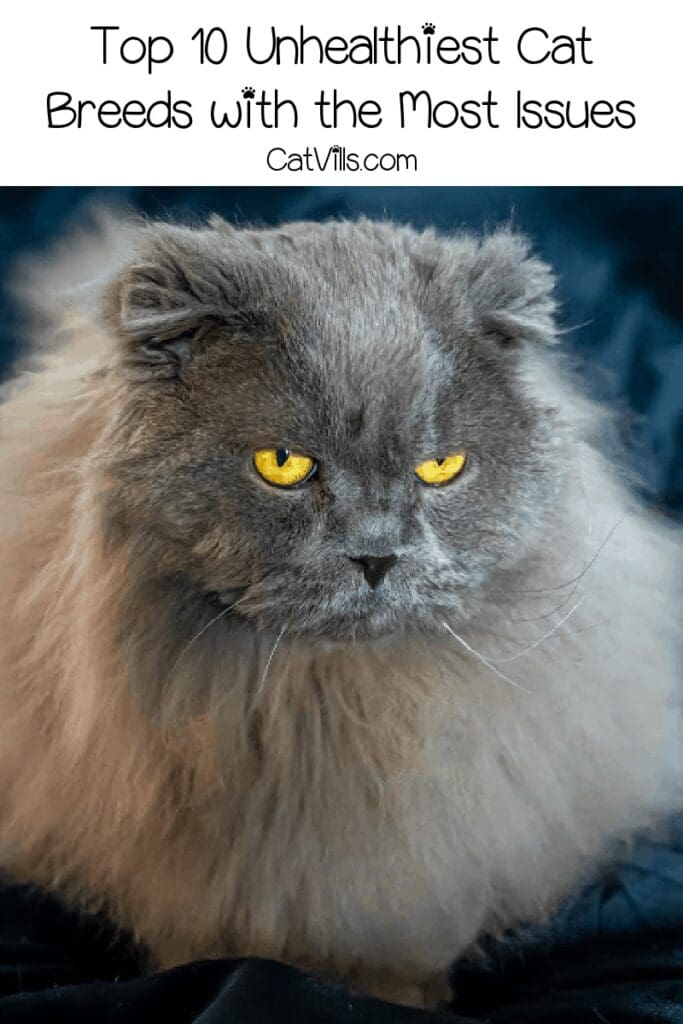Last Updated: 1 year ago
What are the unhealthiest cat breeds of all?
While how you care for your cat plays the biggest role in determining overall health, some breeds are just more prone to problems than others.
It doesn’t mean that every cat of a specific breed will have all or even any of these problems.
We have a lot to go over, so let’s get started.
The Unhealthiest Cat Breeds
These first seven are considered the unhealthiest cat breeds overall, along with potential issues. To clarify, these are issues that are commonly reported.
The last three cats aren’t just among the unhealthiest; they have so many issues that there’s a lot of debate about whether it’s even ethical to continue breeding them.
1. The Bengal

Bengals are fun-loving, curious, and playful cats known for the leopard-like pattern of their short-haired coats.
They are the result of breeding an Asian Leopard Cat with a domestic cat. Brave kitty!
Bengals love to climb, explore, and occasionally even play with water.
Bengals can suffer from several hereditary concerns, including
- Eye problems, including cataracts and progressive retinal atrophy (PRA),
- A heart condition called hypertrophic cardiomyopathy (HCM).
- Knee dislocation and hip dysplasia.
Vets have identified PRA as a hereditary issue in Bengals. It is untreatable and results in progressive blindness.
2. The Ragdoll
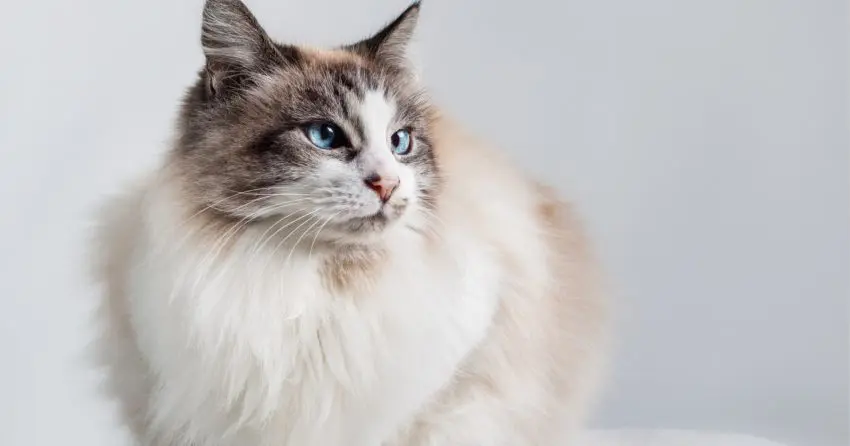
Ragdolls are relaxed, chilled-out, easy-going cats. In other words, the surfer dudes of the cat world.
Much like their name suggests, Ragdolls go limp in your arms when you pick them up.
Rumor has it that the mother of the first Ragdoll was hit by a car before being used for breeding and would often go limp when picked up.
Ragdolls are prone to:
- Hypertrophic cardiomyopathy (HCM).
- Bladder stones and other urinary tract problems.
These blue-eyed beauties are by no means the unhealthiest cats on the list.
Surprisingly, some breeders are trying to liven up the Ragdoll breed a little, as they fear their super relaxed nature can sometimes put them in harm’s way.
3. The Birman
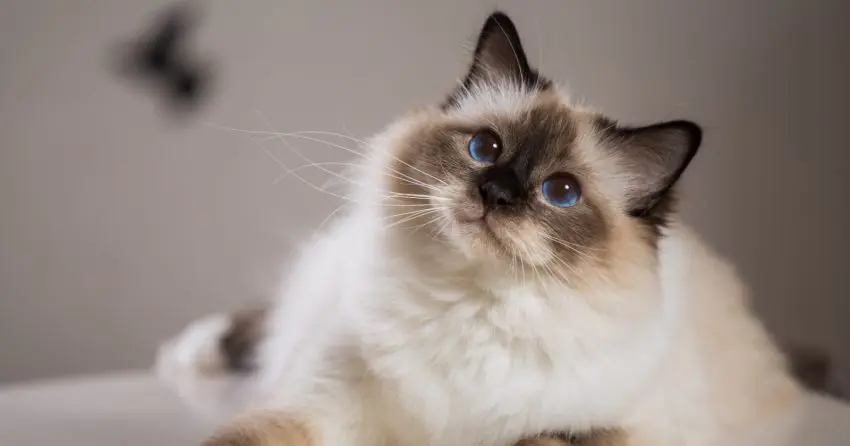
Birman cats have distinctive blue eyes and pure white feet called gloves or socks.
There is no accurate record of the Birman’s origins. Still, the first examples may have arrived in the western world as early as 1919.
Birmans are affectionate, friendly, intelligent companions that love people. Furthermore, it is said they make great family pets.
International Cat Care reports that Birmans are prone to the following conditions:
- Polycystic kidney disease (PKD).
- An inherited genetic short life span of as little as 8 months.
Over 3% of Birmans in France could be carrying this gene. Thankfully, tests are available to detect it.
4. The Persian
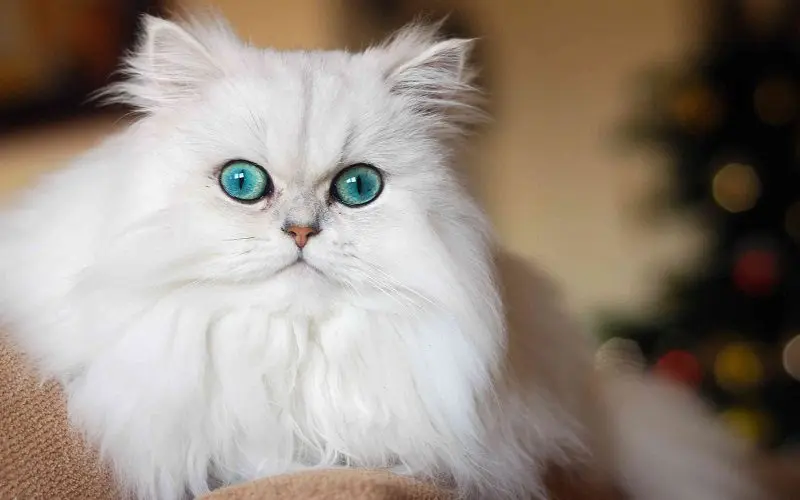
Persians are a prevalent breed known for their long coat and characteristic short nose and muzzle.
Some breeders have taken this to the extreme, and associations see flat-faced Persians with very short noses as the standard.
Persians can suffer from a variety of problems, including:
- Polycystic kidney disease (PKD).
- Breathing issues resulting from their flat faces and short noses.
- Eye problems are also due to their flat faces.
- Feline lower urinary tract diseases (FLUTD), including infections and bladder stones.
Their eye problems can range from overactive tear ducts to cataracts and progressive retinal atrophy (PRA).
5. The Siamese
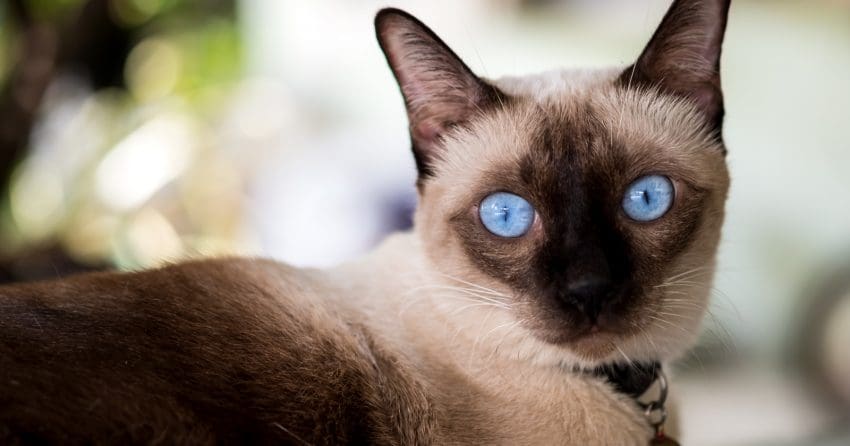
Life with a Siamese is never dull. They are super intelligent, playful, and affectionate attention seekers.
Their triangular head and almond-shaped blue eyes, coupled with their distinctive coloration, give them a unique appearance.
Sadly, Siamese cats are prone to many problems, including:
- Progressive retinal atrophy (PRA) leads to eventual blindness.
- Systemic amyloidosis is a buildup of protein in organs that stops them from working.
- Lung cancer.
- Respiratory problems, including asthma.
- Hip dysplasia.
Breeders have crossed the Siamese with many other breeds to create a large number of new breeds.
From Balanise to Mekong Bobtail, they all stem from the Siamese.
6. The Exotic Shorthair
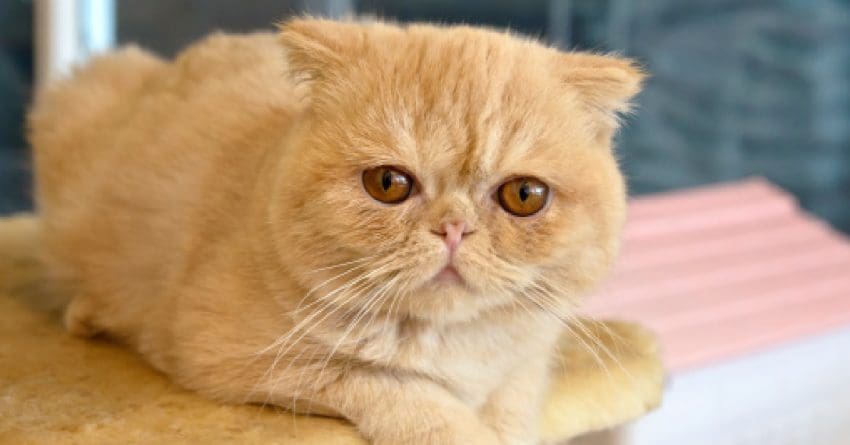
The Exotic Shorthair is essentially a short-haired version of the Persian. They have a similar body shape and the same distinctively flattened face.
These exotic cats are gentle, playful, and affectionate, and they love some attention from their humans.
They are very similar to Persians and, as a result, face many of the same health problems.
In fact, breeders created the Exotic Shorthair by crossing American Shorthairs with Persians in the 1950s.
The Pet Health Network lists Exotics as being prone to the following problems:.
- Polycystic kidney disease (PKD).
- Breathing problems stem from their flat face and squared skull.
- Eye problems, including progressive retinal atrophy (PRA),
- Hypertrophic cardiomyopathy (HCM).
7. The Sphynx

The Sphynx is a hairless breed of cat. The breed originated from a natural mutation that resulted in a domestic cat being born without hair.
Sphynx cats aren’t actually bald; they are instead covered in a fine down coat. They are smart, curious cats who love company.
Sphynx cats can suffer from the following conditions:
- Hypertrophic cardiomyopathy (HCM).
- A variety of skin problems.
- Periodontal disease is a bacterial gum infection that leads to pain and tooth loss.
A hairless cat may mean no brushing, but they still require a different kind of grooming. Sphynx cats need regular baths to prevent a buildup of skin oil.
The Cat Breeds With Most Health Problems
Sure, the breeds listed so far have their share of problems.
Some are worse than others; indeed, many could have been swapped out with other breeds that suffer from similar conditions.
The following breeds are among the worst affected. As a result, there is some debate surrounding the ethics and morality of continuing to breed them.
8. The Munchkin
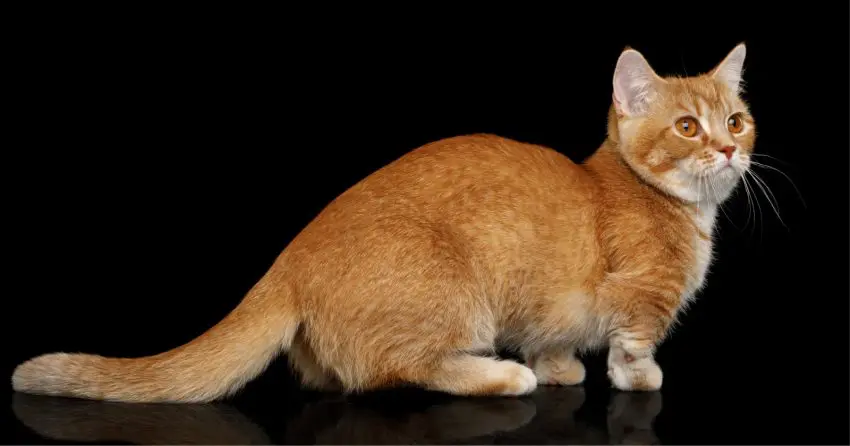
Munchkins are characterized by their short legs.
The University Federation for Animal Welfare explains that the Munchkin’s short legs are the result of a genetic mutation.
The bones in their legs don’t grow properly, so they can’t move like a typical cat. It can also lead to osteoarthritis and a lot of pain.
All Munchkins are affected by the gene, and kittens can die prior to birth if they receive a copy of the bad gene from both parents.
Several cat associations around the world refuse to recognize the Munchkin, but others support and encourage continued breeding.
9. The Manx Cat
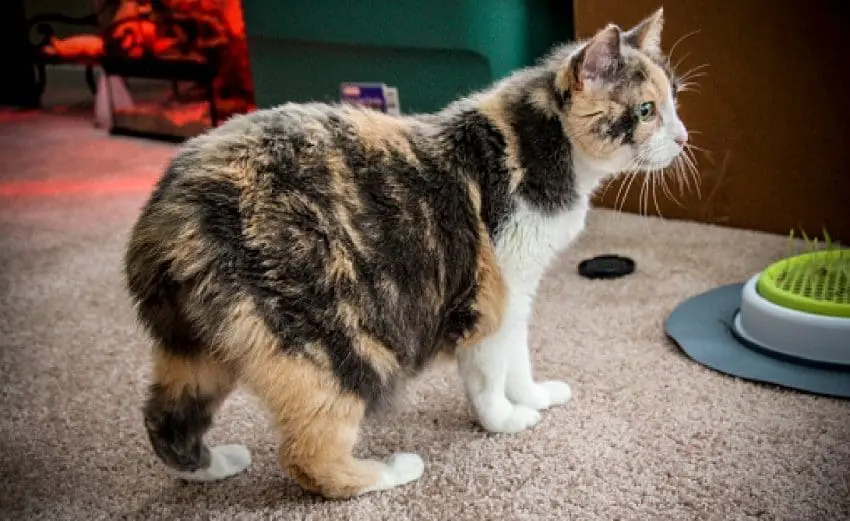
We know Manx cats for their stumpy or missing tails. However, the gene responsible for this trait can cause health problems too.
Manx cats can suffer from arthritis and corneal dystrophy, an eye disease.
In addition, they are prone to Manx syndrome, a number of conditions including a shortened spine, urinary tract problems, and digestion issues.
Somewhere in the region of 20% of all Manx cats are affected by Manx syndrome. Symptoms will generally appear by the time a cat reaches 4 months.
10. The Scottish Fold
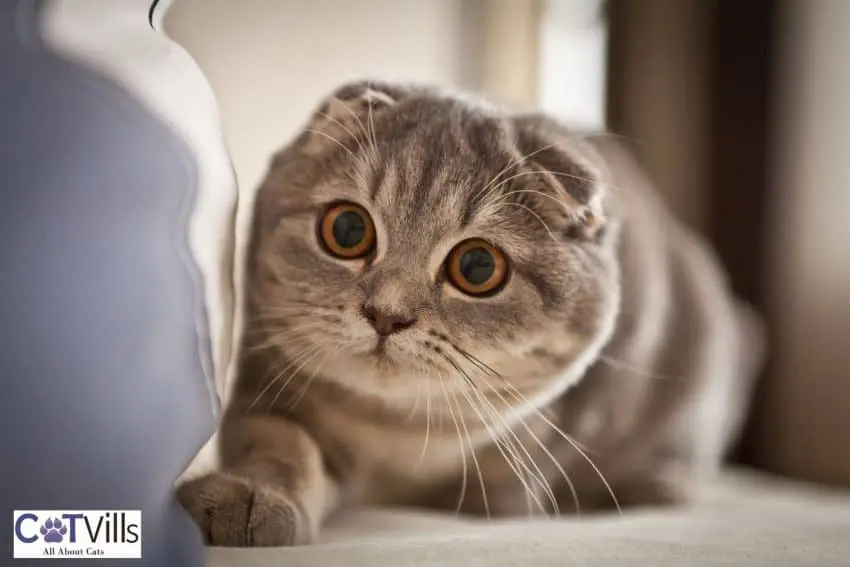
The Scottish Fold may be cute in appearance, with ears that fold down and forward. However, the gene responsible for this causes other deformities.
RSPCA Australia states that the inherited defect affects the cartilage and can lead to abnormal growth of bones and joints.
There is no cure for the defect, so cats can be left in pain or with a limited range of movement.
Consequently, some competitions and associations have banned the breed; however, breeding continues.
The RSPCA advises that the best way to prevent the suffering this condition causes is to stop breeding any cats with folded ears altogether.
What can make a cat unhealthy?
Now that we’ve looked at the unhealthiest cat breeds, it’s worth taking some time to understand what can make any cat ill.
Poor health isn’t necessarily a breed-specific problem; indeed, all cats can suffer from illness and injury.
Neglect
Your cat relies on you, his owner, to take good care of him.
While he may still have many of his ancestors’ wild survival instincts, he can’t drive himself to the vet.
In my experience with feral cats, they are resourceful. Still, they can often get dangerously sick with easily preventable and treatable illnesses.
The tips below will help you keep your cat as healthy as possible. Most of them are common sense, but they are still worth repeating
- Feeding: Give your kitty high-quality cat food and follow the recommended portions. Fresh, clean water is essential too.
- Grooming: Brush your cat’s coat regularly; it helps keep his fur clean and reduces hairball problems.
- Accommodation: Indoor cats tend to live longer, so consider if you want yours to go outside.
- Litter Box: Litter boxes need to be kept clean and the litter changed regularly.
- Claws: Provide a scratching post for your cat and trim his nails every two to three weeks.
- Vet Care: Your veterinarian carries out health checks and advises on vaccinations, neutering, and other treatments.
Environment
Researchers from Ontario Veterinary College and the University of British Columbia have published a paper detailing the risks faced by outdoor cats.
- Increased risk of catching a disease or parasite.
- Car collision injuries.
- Trauma injury caused by wildlife, dogs, or other cats.
- Accidental or intentional poisoning.
Genes
International Cat Care tells us that hereditary health problems are the result of irregular genes that have been passed down through generations of cats.
These inherited illnesses and conditions can affect all cats; however, they are more common in purebreds.
This is the result of the selective breeding and inbreeding techniques used to give pedigree cats their specific traits.
The distinctive look of some breeds is due to an inherited defect.
The defect makes them look a certain way; however, it can also be harmful to the cat’s health.
Genetic testing is helping responsible breeders screen their cats in an effort to manage these problems.
Common Cat Illnesses
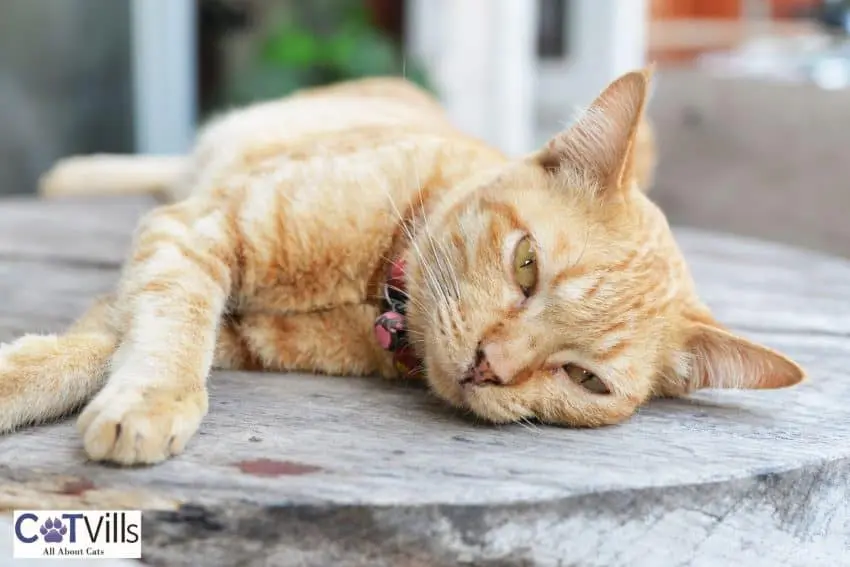
We’ll look at some breed-specific ailments in our list of the unhealthiest cat breeds below. However, numerous common diseases can affect any cat.
Here are the most common cat diseases, according to the ASPCA.
- Cancer – Cancer cells grow, invade nearby tissue, and can spread throughout the body uncontrollably.
- Diabetes: Similar to humans, cats can experience both type I and type II diabetes. The disease involves problems with insulin production and response.
- Feline Immunodeficiency Virus (FIV): FIV is the cat equivalent of the virus that causes AIDs in humans. It seriously weakens their immune system.
- Feline Leukemia Virus (FelV): FelV is another disease that gravely weakens a cat’s immune system.
- Heartworm: Mosquitos spread these parasites that actually cause lung disease in cats, in spite of what the name might suggest.
- Rabies: Rabies affects the brain and nervous system of cats. It is highly fatal.
- Upper Respiratory Infections: Viruses and bacteria can cause infections in a cat’s nose, throat, and sinuses.
- Worms: Cats are vulnerable to a mixture of intestinal parasites. Symptoms are not always apparent, and they can become a serious problem.
Final Word
We’ve learned that, generally speaking, a mixed-breed cat is likely to have the best chance of avoiding hereditary conditions.
On the other hand, pedigree cats are more likely to inherit health issues from their parents due to a smaller gene pool.
The unhealthiest cat breeds have traits that result from the same genes that also give them health problems.
Then again, not all cats of a specific breed will suffer from the associated problems, and responsible breeding cat care is needed.
Breed associations can help you find a trustworthy breeder and find a healthy example of your favorite cat breed.
Which breeds do you consider to be the unhealthiest cat breeds? Share below!
